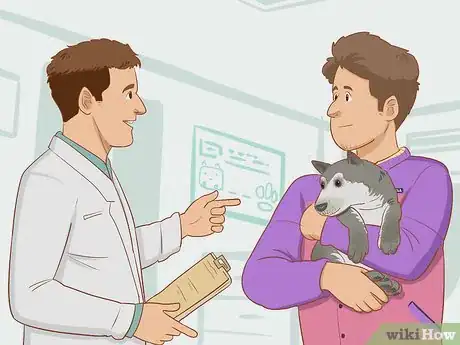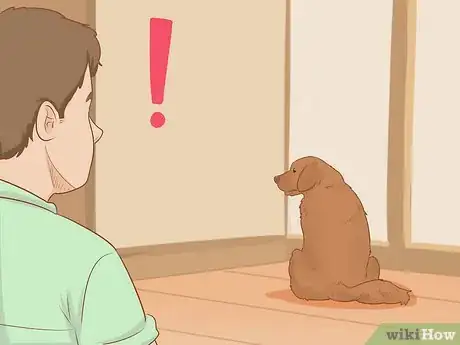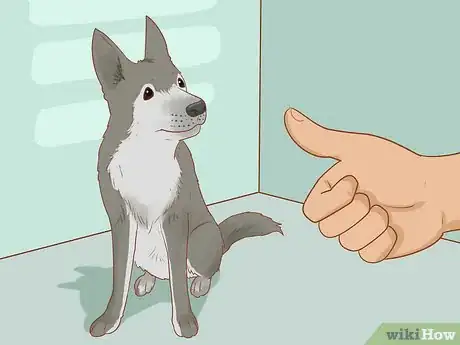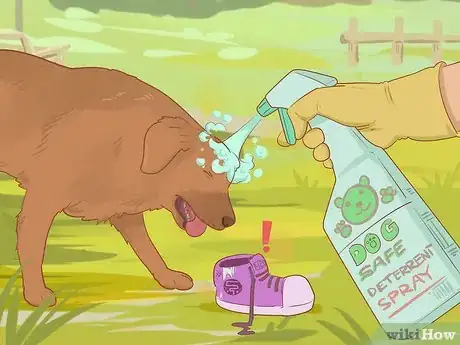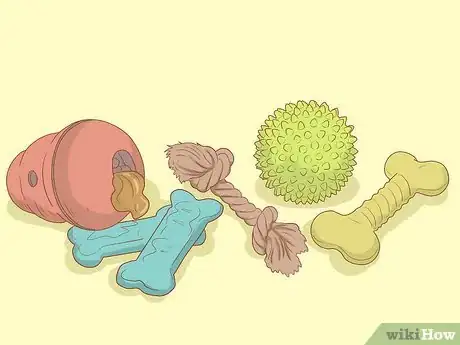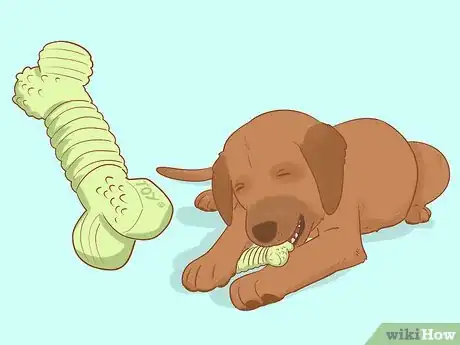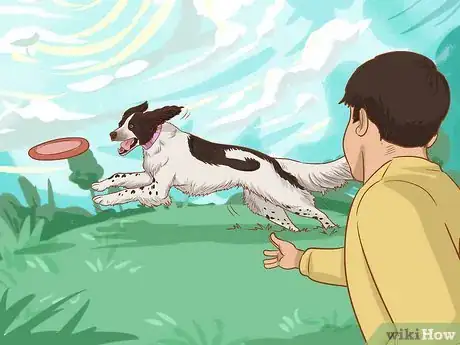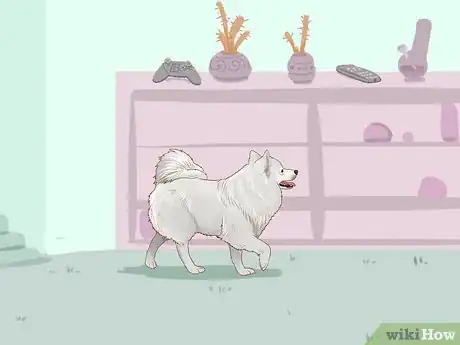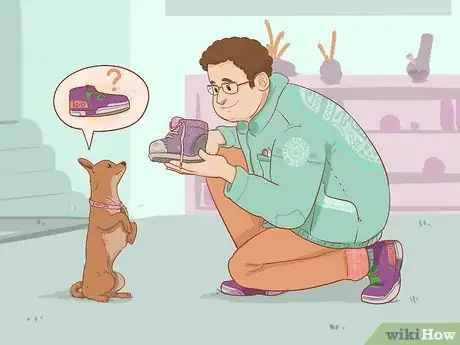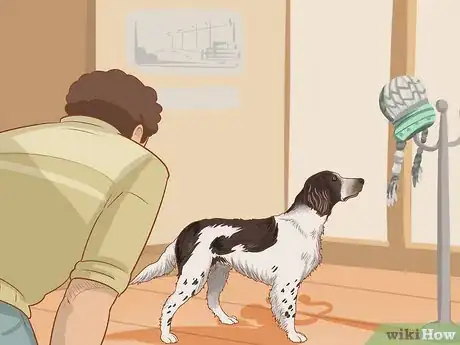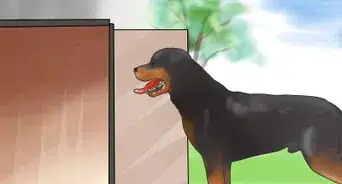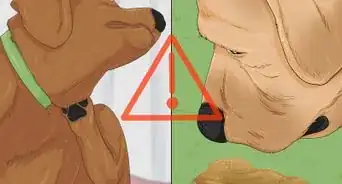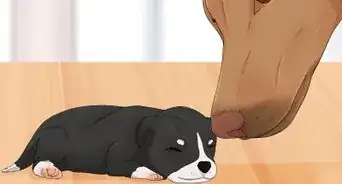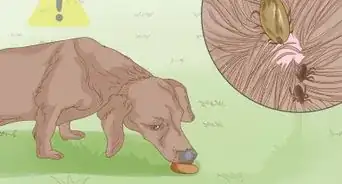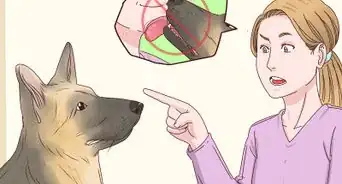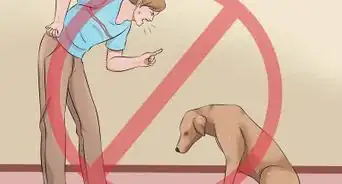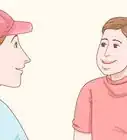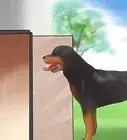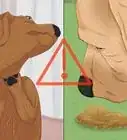This article was co-authored by Elisabeth Weiss. Elisabeth Weiss is a Professional Dog Trainer and owner of Dog Relations NYC, a dog training service in New York, New York. Elisabeth relies on science-based, force-free, and reward-based techniques. Elisabeth offers behavior training, puppy manners, body awareness and injury prevention, diet, exercise and dog nutrition services. Her work has been featured in New York Magazine and on the Dog Save the People podcast. She also trained all the dogs in the movie "Heart of a Dog" by Laurie Anderson that features Elisabeth's journey with Laurie Anderson's and Lou Reed's dog Lolabelle and how her passion for playing the keyboards played a significant role in improving her quality of life after being diagnosed with pancreatic cancer.
There are 11 references cited in this article, which can be found at the bottom of the page.
This article has been viewed 265,866 times.
Nothing’s more fun than playing with a puppy or dog. Your enthusiasm as an owner can wear thin, however, as soon as your dog starts ruining your possessions with frequent chewing. Luckily, with consistent training and smart decisions on the part of the owners, nearly any dog can be trained not to chew its owners out of house and home.
Steps
Training Your Dog not to Chew
-
1Make sure there are no medical causes of the chewing behavior.[1] In some cases, dogs chew as a coping behavior when they suffer from psychological problems (like anxiety). Likewise, if your dog is affected by certain parasites or nutritional deficiencies, they may be compelled to chew all sorts of things. Because of this, consider taking your dog to a veterinarian or animal behaviorist for an expert diagnosis and a suitable treatment plan, especially if the chewing is accompanied by other symptoms, such as weight loss, gastrointestinal problems, or abnormal behavior.
-
2Avoid using negative reinforcement to discourage "bad" chewing. Negative reinforcement means to scold the dog (like saying, "bad dog!") or to punish it. This is an outdated training method which is no longer thought to be effective or kind towards the dog. Instead, to discourage your dog from chewing things they shouldn’t, quickly take the object away from them and immediately replace it with something they can chew. For instance, if your dog has a piece, give them something appropriate to chew (like a treat or toy) and praise them. The dog will soon learn what they can and cannot chew, and without you ever having to scold or punish them.[2]
- If your dog runs away with the object, don’t chase them. Many dogs will interpret this as play behavior, and think of it as a reward.
- Never hit or beat your dog. Most animal societies recommend against using corporal punishment. Moreover, it can lead to other problem behaviors triggered by anxiety.
- Never scold or punish your dog after the fact.[3] This is totally ineffective because the dog will not be able to associate the inappropriate action with the negative reinforcement.
Advertisement -
3Use positive reinforcement to encourage "good" chewing.[4] If you find your dog chewing on something appropriate, approach them calmly and give them enthusiastic, happy praise (using phrases like “good boy!”). You can also offer your dog a small treat.
- Offering praise and treats in this way is positive reinforcement that will encourage good behavior.[5] Pairing the desired action (in this case, chewing appropriately) with praise and food associates the action with feelings of pleasure and satisfaction in the dog’s mind. With consistent training, the good behavior itself becomes its own reward.
- Try rewarding your dog with a treat when they're not doing anything. That way, the dog will begin to understand that a calm dog is a good dog, and they're more likely to enjoy just hanging out. That could make them less inclined to look for things to chew.[6]
-
4Use deterrent sprays.[7] Dogs are much less likely to chew on things with tastes that they find unpleasant. Thus, you can discourage your dog from chewing on certain things by rubbing or spraying them with bad-tasting substances.
- Deterrent sprays in unpleasant flavors like bitter apple are available from pet supply stores. In addition, you can spray a weak solution of a common unpleasant-tasting substance (white vinegar, hot sauce, cayenne pepper, lemon juice, etc.) mixed with water.[8]
- Always use a non-toxic substance. Never try to deter your dog from chewing with a substance that can cause harm or illness.
- This technique works best if your dog has a habit of chewing a particular object, or something immobile. For instance, you can spray chair legs with a bitter apple flavor if your dog has a habit of chewing on them.
- This method is not fool-proof; some dogs will chew even if the item tastes bad.
Giving Your Dog Healthy Alternatives
-
1Encourage good chewing by providing your dog with toys and treats. If you provide your dog with acceptable things to chew on, they will have fewer incentives to chew inappropriate objects. Make sure that your dog has a supply of toys and treats available to them wherever they go. That way, whenever they has the urge to chew, you can offer them something appropriate, or they can find something on their own. Good choices include:[9]
- Rawhide treats
- Chewing strips
- Teething rings
- Ropes
- Squeaky toys
- Raw bones (but no raw bones that can be a choking hazard, such as chicken bones)
- Kong toys (which can be filled with food)[10]
-
2Give teething dogs soothing treats. Like human babies, young puppies go through a period of "teething" as their teeth come in. This can lead young dogs to chew incessantly, even when they're otherwise well-trained. To help with teething, try freezing a wet washcloth and giving it to your puppy to soothe the soreness caused by the teeth coming in.[11]
-
3Make sure to spend time with your dog.[12] Domestic dogs are social creatures that have evolved to be accustomed to contact with humans as well as with other dogs. If they become bored or are kept from contact with other dogs, some dogs can resort to destructive coping behavior, including chewing. Give your dog a chance to meet and play with other dogs, such as at a dog park.
-
4Play with your dog and keep it interested in new things. Dogs don't just want toys; they want fun, happy interactions with the people in their family! Be sure to take the time to play with your dog a little bit every day, especially if they've been chewing. Just twenty minutes or so of play per day can go a long way towards expending a dog's excess energy and calming it down.
- Lots of play and exercise can tire your dog in a safe and beneficial way so that they don't expend extra energy on inappropriate chewing.[13] [14]
- Dog classes are available in many areas.[15] These are an opportunity for pets and owners to practice together to help a dog learn new tricks or behavior. Keeping your dog active in this way can discourage excessive chewing.
Preventing Damage to Your Possessions
-
1Keep objects you don’t want your dog chewing out of their reach.[16] Prevention can be the easiest way to stop your dog from chewing inappropriately, so remove any temptations. Place objects your dog likes to chew (or might chew) out of their reach: in a cabinet, high off the floor, in a bag or box, etc.
-
2Don’t offer your dog confusing items to chew.[19] Your dog may not understand if you offer them items to chew that are very similar to items you do not want them chewing. For instance, if you offer your dog an old shoe to chew on, they might be confused about why you don’t want them to chew on your new shoes. For the best chance of reducing your dog’s inappropriate chewing behavior (and saving your possessions), and avoid treats and toys that resemble things you don’t want them to chew.
-
3Supervise your dog, and keep them separated from things you don’t want it to chew, if necessary.[20] You may notice that your dog resorts to chewing when you are not around. If this is the case, you may consider keeping them confined in a pen, dog crate, or other area while you are gone. You can also use baby gates to keep a dog out of rooms or areas that contain items they're tempted to chew.[21] In addition, you can supervise your dog while you are at home. Even keeping your dog on a leash while you are at home to ensure they doesn’t chew inappropriately can help condition it and encourage positive behavior over time.
-
4Teach your dog the "leave it" command. If you're willing to put in a little extra time and effort, it's possible to teach your dog a handy command that can save your possessions in cases where you catch the dog chewing on them.[22] To teach this command, use the following steps:
- Get two small treats and hide one in each fist. Get the dog's attention with one treat, then sharply tell your dog, "leave it" (referring to the object it is chewing).
- Don't let the dog have the treat. Let them sniff and lick at your hand, but don't let the treat go.
- Ignore your dog if they start to bark or whine. As soon as they lose interest in your hand, however, offer it the treat from the other hand and give them lavish praise.
- Repeat this process until your dog moves away from your hand as soon as you say "leave it." This teaches your dog that ignoring whatever they want to bite or chew on is better than chewing on that thing. Be persistent; do this over and over, and your dog should get the hang of this command.
Expert Q&A
Did you know you can get expert answers for this article?
Unlock expert answers by supporting wikiHow
-
QuestionWhy do dogs chew so much?
 Elisabeth WeissElisabeth Weiss is a Professional Dog Trainer and owner of Dog Relations NYC, a dog training service in New York, New York. Elisabeth relies on science-based, force-free, and reward-based techniques. Elisabeth offers behavior training, puppy manners, body awareness and injury prevention, diet, exercise and dog nutrition services. Her work has been featured in New York Magazine and on the Dog Save the People podcast. She also trained all the dogs in the movie "Heart of a Dog" by Laurie Anderson that features Elisabeth's journey with Laurie Anderson's and Lou Reed's dog Lolabelle and how her passion for playing the keyboards played a significant role in improving her quality of life after being diagnosed with pancreatic cancer.
Elisabeth WeissElisabeth Weiss is a Professional Dog Trainer and owner of Dog Relations NYC, a dog training service in New York, New York. Elisabeth relies on science-based, force-free, and reward-based techniques. Elisabeth offers behavior training, puppy manners, body awareness and injury prevention, diet, exercise and dog nutrition services. Her work has been featured in New York Magazine and on the Dog Save the People podcast. She also trained all the dogs in the movie "Heart of a Dog" by Laurie Anderson that features Elisabeth's journey with Laurie Anderson's and Lou Reed's dog Lolabelle and how her passion for playing the keyboards played a significant role in improving her quality of life after being diagnosed with pancreatic cancer.
Professional Dog Trainer
-
QuestionWhy does my dog chew things when I leave the house?
 Pippa Elliott, MRCVSDr. Elliott, BVMS, MRCVS is a veterinarian with over 30 years of experience in veterinary surgery and companion animal practice. She graduated from the University of Glasgow in 1987 with a degree in veterinary medicine and surgery. She has worked at the same animal clinic in her hometown for over 20 years.
Pippa Elliott, MRCVSDr. Elliott, BVMS, MRCVS is a veterinarian with over 30 years of experience in veterinary surgery and companion animal practice. She graduated from the University of Glasgow in 1987 with a degree in veterinary medicine and surgery. She has worked at the same animal clinic in her hometown for over 20 years.
Veterinarian Chewing is comforting for many dogs, in the same way that a child finds sucking their thumb reassuring. If the dog chews when you are out, it's likely they are missing you and this is their way of coping. Work on ways of making them feel safe when you're out and reducing the anxiety of being left alone.
Chewing is comforting for many dogs, in the same way that a child finds sucking their thumb reassuring. If the dog chews when you are out, it's likely they are missing you and this is their way of coping. Work on ways of making them feel safe when you're out and reducing the anxiety of being left alone. -
QuestionWhy does my dog keep chewing everything?
 Pippa Elliott, MRCVSDr. Elliott, BVMS, MRCVS is a veterinarian with over 30 years of experience in veterinary surgery and companion animal practice. She graduated from the University of Glasgow in 1987 with a degree in veterinary medicine and surgery. She has worked at the same animal clinic in her hometown for over 20 years.
Pippa Elliott, MRCVSDr. Elliott, BVMS, MRCVS is a veterinarian with over 30 years of experience in veterinary surgery and companion animal practice. She graduated from the University of Glasgow in 1987 with a degree in veterinary medicine and surgery. She has worked at the same animal clinic in her hometown for over 20 years.
Veterinarian Chewing is normal dog behavior and a source of great satisfaction for them. Rather than stop the dog chewing altogether, which is not realistic, provide chew toys for the dog. Make these more attractive by smearing them in peanut butter. Be sure to heap praise on the dog when they choose the right thing to chew on. This helps the dog know what's OK to chew and what isn't.
Chewing is normal dog behavior and a source of great satisfaction for them. Rather than stop the dog chewing altogether, which is not realistic, provide chew toys for the dog. Make these more attractive by smearing them in peanut butter. Be sure to heap praise on the dog when they choose the right thing to chew on. This helps the dog know what's OK to chew and what isn't.
References
- ↑ http://www.humanesociety.org/animals/dogs/tips/destructive_chewing.html
- ↑ Elisabeth Weiss. Professional Dog Trainer. Expert Interview. 3 September 2020.
- ↑ http://www.humanesociety.org/animals/dogs/tips/destructive_chewing.html
- ↑ http://www.humanesociety.org/animals/dogs/tips/destructive_chewing.html
- ↑ http://www.humanesociety.org/animals/dogs/tips/dog_training_positive_reinforcement.html
- ↑ Elisabeth Weiss. Professional Dog Trainer. Expert Interview. 3 September 2020.
- ↑ http://www.humanesociety.org/animals/dogs/tips/destructive_chewing.html
- ↑ https://www.aspca.org/pet-care/dog-care/common-dog-behavior-issues/destructive-chewing
- ↑ https://www.pdsa.org.uk/pet-help-and-advice/looking-after-your-pet/puppies-dogs/training-dogs-not-to-chew
- ↑ http://www.humanesociety.org/animals/dogs/tips/destructive_chewing.html
- ↑ http://www.humanesociety.org/animals/dogs/tips/destructive_chewing.html
- ↑ http://www.humanesociety.org/animals/dogs/tips/destructive_chewing.html
- ↑ https://www.animalhumanesociety.org/training/managing-mouthing-and-chewing-young-dogs
- ↑ https://www.aspca.org/pet-care/virtual-pet-behaviorist/dog-behavior/exercise-dogs
- ↑ http://rchumanesociety.org/assets/pdf/Dog_Is_Chewing_Everything.pdf
- ↑ http://www.humanesociety.org/animals/dogs/tips/destructive_chewing.html
- ↑ https://www.akc.org/expert-advice/home-living/protect-your-pooch-from-poisonous-plants/
- ↑ https://www.petmd.com/dog/puppycenter/training/evr_dg_top10_chewing_guidelines
- ↑ http://www.humanesociety.org/animals/dogs/tips/destructive_chewing.html
- ↑ http://www.humanesociety.org/animals/dogs/tips/destructive_chewing.html
- ↑ http://rchumanesociety.org/assets/pdf/Dog_Is_Chewing_Everything.pdf
- ↑ https://www.humanesociety.org/resources/stop-your-dogs-chewing
- ↑ http://rchumanesociety.org/assets/pdf/Dog_Is_Chewing_Everything.pdf
- ↑ http://www.humanesociety.org/animals/dogs/tips/destructive_chewing.html
- ↑ http://rchumanesociety.org/assets/pdf/Dog_Is_Chewing_Everything.pdf
About This Article
To stop your dog from chewing things it shouldn’t, make sure to reprimand it by saying, “No!” or “Bad dog!” any time you catch it chewing something it shouldn’t. Alternatively, consider using a deterrent spray or diluted vinegar on the items your dog is chewing to keep your dog from ruining them. Additionally, offer lots of alternatives for your dog to chew, such as rawhide treats, ropes, or squeaky toys. When you see it chewing on these things, give it a treat or verbal praise to reinforce the positive behavior. For tips on how to tell if your dog’s chewing is caused by a medical condition, read on!
